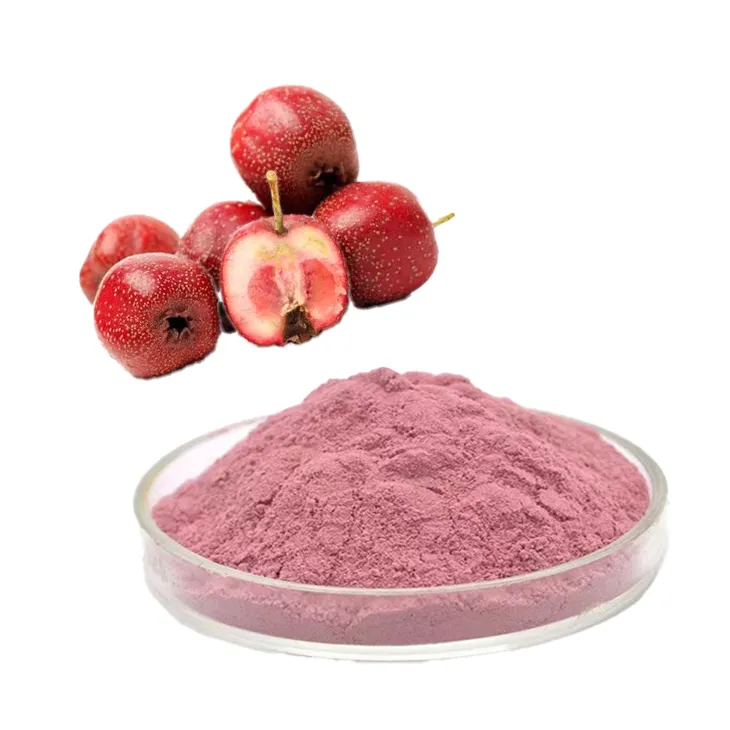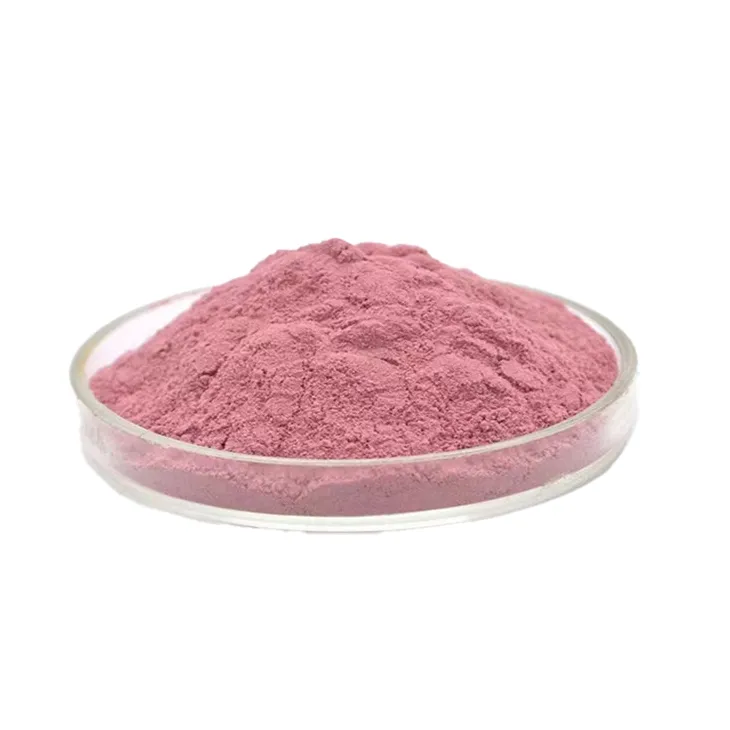- 0086-571-85302990
- sales@greenskybio.com
The extraction process of hawthorn powder.
2024-11-30

1. Sourcing of Hawthorn
The first step in the extraction process of Hawthorn powder is the sourcing of hawthorn. It is crucial to select high - quality hawthorn. Hawthorn can be sourced from various places, such as orchards or local markets. When choosing hawthorn, several factors need to be considered. The appearance of the hawthorn should be intact, without obvious signs of damage or decay. The color of the hawthorn is also an important indicator. For example, ripe hawthorn usually has a bright red color. In addition, the origin of the hawthorn can also affect its quality. Hawthorn from areas with suitable climate and soil conditions is more likely to be of good quality.

2. Washing and Drying of Hawthorn
2.1 Washing
Once the hawthorn is sourced, it needs to be washed thoroughly. This is an important step to remove any dirt, pesticides, or other impurities on the surface of the hawthorn. The washing process should be gentle to avoid damaging the hawthorn. One can use clean water to rinse the hawthorn several times until the water runs clear.2.2 Drying
After washing, the hawthorn needs to be dried under controlled conditions. Drying can be done in several ways. One common method is air - drying. In this method, the hawthorn is placed in a well - ventilated area, away from direct sunlight. Another method is using a drying machine. When using a drying machine, the temperature and humidity need to be carefully controlled. The drying temperature should not be too high, as high temperature may damage the active ingredients in the hawthorn. Usually, a drying temperature of around 40 - 60°C is suitable. The drying process should continue until the moisture content of the hawthorn is reduced to a certain level. This helps to preserve the hawthorn and makes it easier for the subsequent crushing process.
3. Crushing of Dried Hawthorn
The dried hawthorn is then crushed into a more manageable form. Crushing can be achieved using different types of crushers. For small - scale extraction, a simple mortar and pestle can be used. However, for larger - scale production, industrial crushers are more appropriate. When crushing the hawthorn, it is important to achieve a relatively uniform particle size. This not only helps in the extraction process but also ensures the quality of the final Hawthorn powder. The crushed hawthorn should be in a form that allows for efficient extraction of its active ingredients.

4. Extraction Methods
4.1 Traditional Solvent Extraction
Traditional solvent extraction is one of the commonly used methods for extracting Hawthorn powder. In this method, a suitable solvent is selected. Ethanol is often a preferred solvent due to its ability to dissolve many of the active ingredients in hawthorn, such as flavonoids and organic acids. The crushed hawthorn is soaked in the solvent for a certain period of time. This allows the active ingredients in the hawthorn to dissolve into the solvent. The extraction time can vary depending on factors such as the type of solvent, the particle size of the crushed hawthorn, and the desired extraction efficiency. Generally, the extraction time can range from several hours to a few days. During the extraction process, the mixture needs to be stirred occasionally to ensure good contact between the hawthorn and the solvent.4.2 Microwave - Assisted Extraction
Microwave - assisted extraction is a modern extraction method. In this method, the crushed hawthorn and the solvent are placed in a microwave - transparent container. The microwave radiation is then applied to the mixture. Microwave radiation can generate heat rapidly and evenly within the mixture. This heat helps to accelerate the extraction process by increasing the solubility of the active ingredients in the solvent. Compared with traditional solvent extraction, microwave - assisted extraction has several advantages. It is usually faster, as it can significantly reduce the extraction time. It can also improve the extraction efficiency, resulting in a higher yield of the active ingredients. However, when using microwave - assisted extraction, it is important to control the microwave power and extraction time carefully to avoid over - extraction or degradation of the active ingredients.
5. Separation of Extract from Residue
After the extraction process, the extract needs to be separated from the residue. This is usually achieved through filtration. Filtration can be carried out using different types of filters, such as filter paper or filter membranes. The choice of filter depends on the nature of the extract and the required filtration efficiency. For example, if the extract contains fine particles, a filter membrane with a small pore size may be required. During the filtration process, the extract passes through the filter while the residue is retained on the filter. This helps to obtain a pure extract for further processing.
6. Drying of the Extract
The filtered extract still contains a certain amount of solvent. In order to obtain the pure hawthorn powder, the extract needs to be dried. Drying can be done using methods similar to those used for drying the hawthorn. For example, air - drying or using a drying machine can be applied. The drying process aims to remove the solvent completely, leaving behind only the active ingredients and other substances from the hawthorn. The drying conditions, such as temperature and humidity, need to be carefully controlled to ensure the quality of the dried extract.
7. Milling and Sieving to Obtain Hawthorn Powder
Once the extract is dried, it is in a solid form. To obtain the final hawthorn powder, milling and sieving operations are carried out. Milling can be done using a grinder or a mill. The dried extract is ground into a fine powder. After milling, sieving is necessary to remove any large particles or aggregates. A sieve with an appropriate mesh size is used. The powder that passes through the sieve is the pure hawthorn powder. The obtained hawthorn powder can be further analyzed for its quality, such as the content of active ingredients, and then packaged for various applications, such as in the food or pharmaceutical industries.
FAQ:
What are the key factors in sourcing hawthorn for powder extraction?
The key factors in sourcing hawthorn for powder extraction include freshness, ripeness, and freedom from pests and diseases. High - quality hawthorn should be fully ripe as it contains more of the beneficial compounds. Also, it should be sourced from a clean environment to avoid contamination.
Why is drying important in the hawthorn powder extraction process?
Drying is important in the hawthorn powder extraction process because it reduces the moisture content. This helps in preventing the growth of mold and bacteria during storage. Also, dried hawthorn is easier to crush and handle during the subsequent steps of extraction.
What are the advantages of using microwave - assisted extraction?
Microwave - assisted extraction has several advantages. It can significantly reduce the extraction time compared to traditional methods. It also often results in a higher yield of the desired compounds as it can enhance the mass transfer. Moreover, it may require less solvent, which is more environmentally friendly.
How does filtration work in separating the extract from the residue?
Filtration works by passing the mixture of the extract and residue through a filter medium. The filter medium has pores that are small enough to retain the solid residue while allowing the liquid extract to pass through. There are different types of filters such as paper filters, membrane filters, etc., which can be chosen based on the nature of the extract and the required purity.
What is the purpose of milling and sieving in obtaining pure hawthorn powder?
The purpose of milling is to further break down the dried extract into a fine powder. Sieving then helps in removing any remaining large particles or impurities. This ensures that the final hawthorn powder is of a uniform size and high purity.
Related literature
- Optimization of Hawthorn (Crataegus spp.) Powder Production for Nutraceutical Applications"
- "Hawthorn Extract: Chemistry, Pharmacology, and Clinical Applications"
- "Advanced Extraction Techniques for Hawthorn - Derived Bioactive Compounds"
- ▶ Hesperidin
- ▶ Citrus Bioflavonoids
- ▶ Plant Extract
- ▶ lycopene
- ▶ Diosmin
- ▶ Grape seed extract
- ▶ Sea buckthorn Juice Powder
- ▶ Fruit Juice Powder
- ▶ Hops Extract
- ▶ Artichoke Extract
- ▶ Mushroom extract
- ▶ Astaxanthin
- ▶ Green Tea Extract
- ▶ Curcumin
- ▶ Horse Chestnut Extract
- ▶ Other Product
- ▶ Boswellia Serrata Extract
- ▶ Resveratrol
- ▶ Marigold Extract
- ▶ Grape Leaf Extract
- ▶ New Product
- ▶ Aminolevulinic acid
- ▶ Cranberry Extract
- ▶ Red Yeast Rice
- ▶ Red Wine Extract
-
Citrus bioflavonoids
2024-11-30
-
Hericium erinaceus extract powder
2024-11-30
-
Citrus Aurantii Extract
2024-11-30
-
Hawthorn powder
2024-11-30
-
Uridine-5'-monophosphate Disodium salt
2024-11-30
-
Red Wine Extract
2024-11-30
-
Calendula Extract
2024-11-30
-
Lycopene
2024-11-30
-
Hops Extract
2024-11-30
-
Feverfew Extract
2024-11-30




















